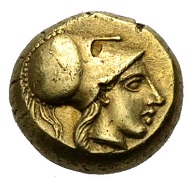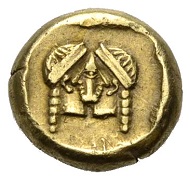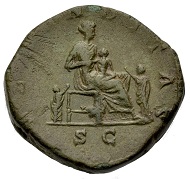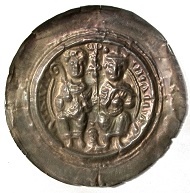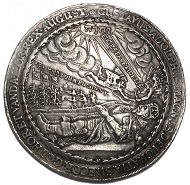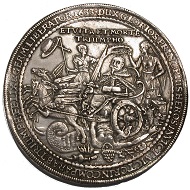24-11-2016 – 01-01-1970
Auction 44
Greek coins and brakteates
The 44th auction of Münzen & Medaillen GmbH, Weil am Rhein, to be held on Friday 25th November in Stuttgart, includes an interesting selection of Greek and Roman coins originating from several private collections, some medieval and modern coins, and numismatic books.
Lot 54: Lesbos. Mytilene. Electrum hekte, ca. 430 B.C. From the collection of Prof. E. Langlotz. Extremely Fine. Estimate: 1,800 EUR.
The first part of the sale begins with an outstanding private collection. This begins with the coins of Greek Italy, including an uncia minted at Luceria in Apulia with a frog on the reverse. This is followed by a selection of nomoi of Lucania, including an example from Hyele (Velia) formerly in the Ermitage in St. Petersburg, and others from Metapontum and Thurium. Sicily is also well represented, with many coins originating from the collection of the art historian Professor E. Langlotz, a rare bronze of Morgantina from the collection of M. Lafaille, and a silver dilitron minted in the same city under the Sikeliot League. The tyrant of Syracuse, Gelon II is portrayed on an extremely fine didrachmon minted in 216 B.C. under his father, Hieron II. Other attractive portraits from the ancient world can be seen on the postumous tetradrachm of Alexander from Myrina and the didrachmon of Philip V of Macedon.
As well as historical individuals, there are many representations of mythical figures, animals and mythical beasts on the coins. The portrayal of Europa in a plane tree with the bull depicted on the coin reverse from Gortyna in Crete is well known. Other striking images occur on the electrum hektai of Mytilene, such as the geometrical depiction of two interlinking heads. From further east come a fine Satrap’s head from Mallos in Cilicia, a drachm from Antiochos III from Apameia with an elephant reverse as well as several Bactrian coins – a drachm of the Greek Satrap Sophytes (325-300 B.C.), a gold stater of Diodotos and a tetradrachm of Euthydemos.
The sale continues with Greek coins from other collections, and Roman coins. Here there are also many rarities, including coins from the Black Sea region and a range of Rhodian coins with different magistrates’ names and symbols. Amongst the Roman coins are coins of Mark Antony minted during the Civil wars and two denarii of Octavian from the same period: also on offer are two coins minted after he took the title of Augustus, one portraying him with the corona civica and depicting the laurel trees which he was given for ‘saving’ the Roman citizens during the Civil War, and a second of the PONTVS MAXIM type.
Lot 348: Lucilla (died 182), wife of Lucius Verus, daughter of M. Aurelius. Sestertius. Very fine. Estimate: 280 EUR.
This auction includes a special collection of the coins of Annia Aurelia Galeria Lucilla (d. 182), the daughter of Marcus Aurelius and his wife Faustina, minted during her marriage to Lucius Verus. Her husband was the son of L. Aelius, whom the childless Hadrian had adopted as his successor in A.D. 136. Aelius, however, died young, and as Lucius Verus was only 8 years old at the time, Hadrian was forced to adopt a second heir, Antoninus Pius. Antoninus was instructed to raise Lucius Verus together with his own nephew Marcus Aurelius as potential successors. To cement the family ties, Lucilla was engaged to Lucius Verus in 161 and then (at the age of about 16 or 17) married in 164. The coins were minted in her name during her time as empress from 164 to 169, when Verus, who despite bad health had gone to fend off an attack of the Marcomanni in Northern Italy, died of a stroke at the age of 39. At the age of about 21 Lucilla was now a widow and no longer an empress. Marcus Aurelius, now the sole emperor of Rome, arranged a second marriage for her – staying single was not an option for a female member of the ruling house in childbearing age – with Tiberius Claudius Pompeianus, a senator. But he was not an emperor, and Lucilla was not content with her fate. As she saw that her brother Commodus, who became sole emperor upon Marcus Aurelius’ death in 180, ruled in an increasingly erratic manner and was alienating the Roman Senate, she supported a conspiracy against him, probably in 181, which was led by Commodus’ nephew. When the plot failed, Lucilla was put to death.
The auction continues with later Roman imperial and Byzantine coins, including some rare issues of Aurelian and other 3rd and 4th century issues with unusual bust types.
Lot 489: Hersfeld, abbey. Johann I, 1201-1213, and Philipp von Schwaben. Bracteate 1201-1208, Breitungen. Extremely fine. Estimate: 2,500 EUR.
The medieval coins consist mainly of rare and superb German bracteates.
Los 515: Pomerania as Swedish possession. Gustav II. Adolf, 1630-1633, double taler 1633, Wolgast mint. Very fine-extremely fine. Estimate: 2,000 EUR.
There follows a small collection of coins of the German Kaiserreich and the Weimar Republic.
Some French medals on marriages are offered, some of them historically interesting.
The sale concludes with 260 lots of numismatic books.
The auction lots can be viewed on Sixbid and Numisbids.
Live bidding during the auction is possible for customers who have been registered in advance through Biddr.
You may also wish to read our Article of the Week discussing in detail the Lucilla coins.




